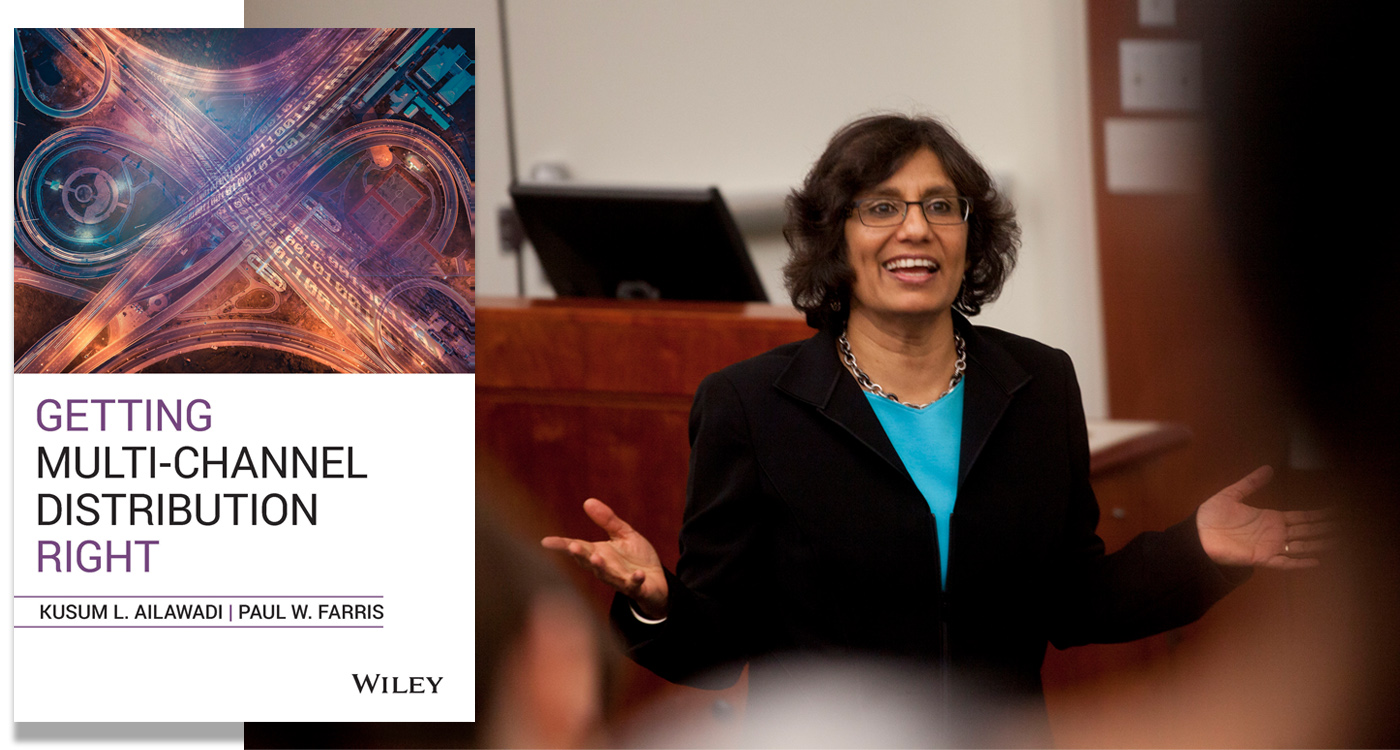Navigating the Many Routes to Consumers
In a new book, "Getting Multi-Channel Distribution Right," Tuck professor Kusum Ailawadi melds research with practical tools on how suppliers can select and manage the physical and digital channels through which their products reach consumers.

The goal of her new book is to have current and future managers incorporate her research-based metrics, frameworks, and dashboards into their thinking as they wrestle with the distribution challenges they face, says Ailawadi.
When you buy something online and it shows up at your door, it’s easy to discount the complexity of the decisions and relationships behind the scenes that made it happen.
For example, you can order a pair of Brooks running shoes on Amazon, but they’re not sold by either Brooks or Amazon—one of Brooks’ omnichannel retailers is likely the dealer of record. Or, if Nikes are more your style, you can find an odd size of a model or two on Amazon, but it will probably come from an unauthorized retailer. Every company today has to manage more than one route to reach customers, whether it’s a digital-native like Jessica Alba’s The Honest Company realizing it needs to be on the grocery store shelf after all; a home furnishings manufacturer trying to meet customers wherever they search and buy; a hotel company deciding what being available on Expedia is worth; or a media company figuring out what price is sustainable for its direct streaming channel and which content to license to Netflix.
As distribution options multiply, making the right choices is critical and product line, pricing, and other decisions are becoming more complex along with distribution decisions. This is something Kusum Ailawadi, the Charles Jordan 1911 TU’12 Professor of Marketing at Tuck, understands well. She’s spent a decade teaching her MBA students this topic in her course Multichannel Route-to-Market Strategy and more than two decades researching various aspects of the interaction between suppliers and their channel partners. In that time, while becoming fluent in the challenges, language, and tools of multichannel distribution, she noticed that there wasn’t a definitive resource on the modern distribution system for managers and MBA students or those who train them. So, she decided to partner on a book with her long-time research collaborator and friend, Paul Farris, the Emeritus Landmark Professor of Marketing at the Darden School of Business.
Don’t forget that a partner today may become a competitor tomorrow and that the balance of power shifts over time. Work hard to earn the consumer’s search loyalty and accumulate power but try to use that power without using it up.
The product of their years-long work is Getting Multichannel Distribution Right (John Wiley & Sons), a comprehensive and practical guide to the strategies, metrics, and tools suppliers need today to navigate the many ways they can reach the end consumer, and manage relationships with the many intermediaries they have to partner with.
To get a sense of the challenges suppliers face, consider the case of performance running shoe manufacturer, Brooks, a company Ailawadi and Farris discuss at length in the book. “It is focused on the runner and distributes its full product line through multiple channels, from specialty running stores to omni-channel general sporting goods chains and some pure-play online retailers, and it has its own direct digital channel,” they write. Aside from servicing all those channels, Brooks must come up with ways to capture important metrics across the channels, such as who searches and buys where and why, and the breadth and depth of distribution, in addition to prices and margins. It has to manage the channel conflicts that arise when, say, runners get their gait and the shape of their foot checked at Fleet Feet and then buy their Brooks shoes on Amazon, while at the same time filling the holes in distribution that are left by the increasing rate of physical store closures.
Or take the hotel industry, where a rather fragmented group of hotel companies and independent hotels depend on the two behemoths of the booking business, Booking Holdings and Expedia, and increasingly on Google Travel. Online travel agencies (OTAs) are attractive to consumers because they offer one-stop comparison shopping. Meanwhile, hotels must pay OTAs commissions of 12 percent to as much as 50 percent for bookings on top of having to offer low prices on the rooms. Large companies like Marriott, made even larger after the merger with Starwood, can negotiate better deals with OTAs. But even so, Ailawadi and Farris advise that the deals reflect a clear understanding of the specific functions the OTAs perform and what they are worth. They also underscore the short and longer-term ramifications of entering into new agreements and modifying existing ones, offering a lesson in détente: “Don’t forget that a partner today may become a competitor tomorrow and that the balance of power shifts over time,” they write. “Work hard to earn the consumer’s search loyalty and accumulate power but try to use that power without using it up.”
These are two of the many cases Ailawadi and Farris use to animate and explicate the distribution problem, but the bulk of the book is grounded in research-based frameworks, metrics, and tools that will help managers do their jobs, and MBA students learn the skills necessary to get those jobs. The book is organized into three sections: (1) the bedrock, which describes today’s physical and digital intermediaries, their functions, their sources of power and the root causes of conflict in the system; (2) the metrics, tools, and frameworks for getting the right type and intensity of distribution; and (3) the ongoing marketing mix decisions needed to keep the system well-oiled and running smoothly. Taken together, the book is the first of its kind to address the modern distribution landscape in a holistic and rigorous way.
“Our goal for this book,” Ailawadi says, “is to have current and future managers incorporate our research-based metrics, frameworks, and dashboards into their thinking as they wrestle with the distribution challenges they face, while learning from our case studies on how other companies, from very different industries, have dealt with them.”
For more information about the book, visit www.getmultichannelright.com.

